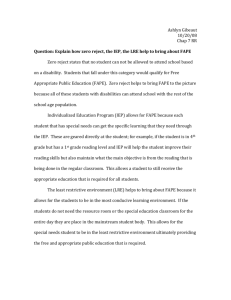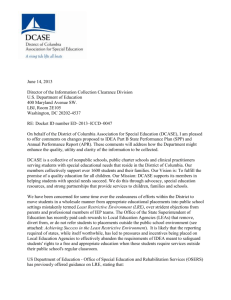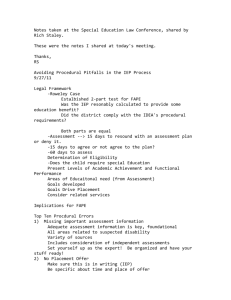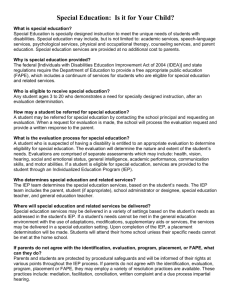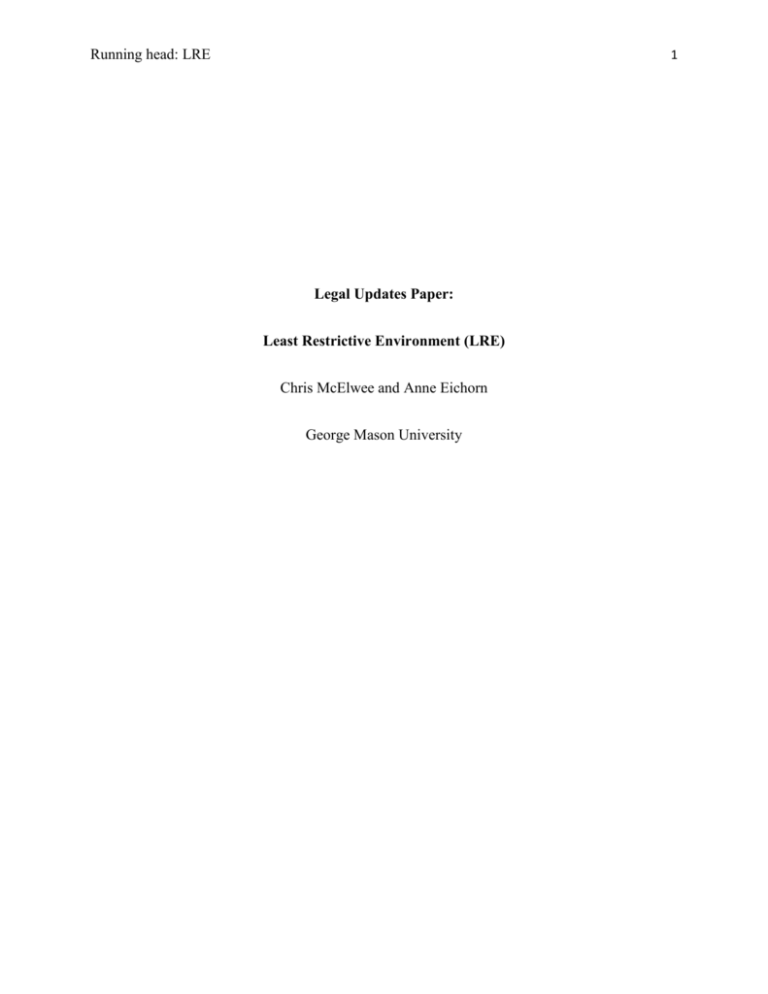
1
Running head: LRE
Legal Updates Paper:
Least Restrictive Environment (LRE)
Chris McElwee and Anne Eichorn
George Mason University
2
Running head: LRE
Overview
At the core of the Individuals with Disabilities Education Act (IDEA) is a requirement
that indicates that students with disabilities are to be educated “… to the maximum extent
appropriate … with children who are nondisabled; and … Special classes, separate schooling, or
other removal of children with disabilities from the regular educational environment occurs only
if the nature or severity of the disability is such that education in regular classes with the use of
supplementary aids and services cannot be achieved satisfactorily” (20 U.S.C. § 300.114 (a)).
This Least Restrictive Environment (LRE) mandate ensures that every school which accepts
federal funding educates students with disabilities in settings with students without disabilities to
the maximum extent appropriate. Furthermore, it is only when a free and appropriate public
education (FAPE) cannot be provided, even with supplementary aides and services; that students
with disabilities may be placed in more restrictive environments other than the general education
setting (Yell, 2006).
What constitutes an LRE and, therefore, a FAPE is controversial and varies from state to
state. In this paper we will first explore various court decisions, which have laid the foundation
for court decisions with regard to the placement and, thus, LRE for students with disabilities.
Legal Context
The first court case involving FAPE, which has impacted recent LRE court decisions,
was Hendrick Hudson School District v. Rowley in 1982 with the Supreme Court’s decision that
interpreted the FAPE mandate under IDEA. The Supreme Court considered the meaning of
FAPE and developed a two-part test in determining appropriate placements for students with
disabilities. The Supreme Court ruled that the student with disabilities was entitled to an
Running head: LRE
3
education that was reasonably calculated to confer educational benefit, not the “best” benefit
(Yell, 2006).
In 1983, the aforementioned Supreme Court decision was followed by various cases
involving FAPE through the consideration of the LRE. The least restrictive environment for
students with disabilities has been interpreted differently by various federal circuit courts. Due
to the fact that parents and school districts are often in disagreement concerning the placement or
LRE for their student with disabilities, litigation has been prevalent in this area. Also, because
the Supreme Court has not accepted a case concerning the interpretation of the LRE mandate,
various circuit courts have established some consistency with respect to the interpretation of this
mandate. These cases have been judged as significant when determining placement in the LRE
for a student with a disability. Further, the tests derived from them have become the judicial
standards of review in LRE cases in various circuit courts (Yell, 2006). When considering the
rulings of the current court cases presented in this paper, three of these precedent cases were
indicated as being considered in each of the judges’ holdings; Roncker v. Walter (1983), Daniel
R.R. v. State Board of Education (1986), and Hartmann v. Loudoun County Board of Education
(1997).
The first case, Roncker v. Walter (1983), the Sixth Circuit Court of Appeals developed a
test, the Roncker portability test. This case helped courts decide whether a segregated placement
was superior or not to a nonsegregated setting, and could the services in this segregated setting
be replicated in the nonsegregated setting. This case also demonstrated the presumption that
Congress had a strong preference for including children with disabilities with their nondisabled
peers (Palley, 2006).
4
Running head: LRE
A few years later in 1989, the Court of Appeals for the Fifth Circuit established
precedence by determining that a school district could remove a mentally retarded student from a
prekindergarten setting in Daniel R.R. v. State Board of Education. The Fifth Circuit established
a two-part test to determine the appropriateness of an inclusive setting (Palley, 2006). The Daniel
Two-Part Test devised two questions, which encompassed the usefulness of supplementary aids
and services in the general education classroom and whether the student was integrated into the
general education environment to the maximum extent possible. This test was developed to help
courts determine compliance with the LRE requirement (Yell, 2006).
The third case that relates to the more current cases explored in this paper has also
become a judicial standard of review for the courts when determining LRE for students with
disabilities in the public school setting. In Hartmann v. Loudoun County Board of Education
(1997), the Fourth Circuit court considered the case of an 11-year old child with autism and
whether the child would be appropriately placed in a separate self-contained special education
class with mainstreaming only in the areas of art, music, physical education, library, and recess.
The court developed a three-part test from the consideration of Hartmann v. Loudoun County
Board of Education (1997), with the intent of guiding courts in deciding when mainstreaming
was not required (Yell, 2006).
Legal and Ethical Critique of Cases
The courts have based their decisions on cornerstone cases as well as various
circumstances which relate back to the premise that students with disabilities should be educated
to the maximum extent possible with their nondisabled peers. As noted previously, the
aforementioned three tests and cases in addition to the LRE mandate in IDEA and the Rowley
Running head: LRE
5
two-part test, form the judicial standards when determining placement in the LRE for students
with disabilities in the following cases. A review of these cases revealed the use of these tests by
various courts as considerations in their premise for their holdings. As the following cases are
delineated, the emphasis of our discussion will concern the connection between the
aforementioned precedence and the holdings of the judges in each case with respect to the least
restrictive environments of the students.
Three cases that depended mainly on Rowley are County School Board of Henrico
County, Virginia v. R.T. (2006). , D. v. Board of Education of Aptakisic-Tripp Community
Consolidated School District (2009), and J.D. v. New York City DOE (2008). In the first case,
County School Board of Henrico County, Virginia v. R.T. (2006), the school district appealed a
State Hearing Officer’s decision that the School Board had failed to provide R.T., a student with
autism, a FAPE under IDEA. The issue was that the mother contended that R.T. was not
benefitting from the public school placement in a public school autism program. The mother
contended that, through the private school placement and programming that she pursued, R.T.
was progressing, as opposed to his lack of progress in the public school setting. Using the
Rowley (1982) case as the basis of their holding, the Court upheld the H.O.’s decision, agreeing
with the mother that the placement in the private school provided an educational benefit for R.T.
The issue in D. v. Board of Education of Aptakisic-Tripp Community Consolidated
School District (2009), concerned the decision of whether FAPE under IDEA was denied to a
student when the student was not placed in a more restrictive environment. The parents
unilaterally enrolled their daughter, Sarah, in a private school and claimed the district had denied
the student a free appropriate public education. They were unsuccessful in gaining
reimbursement for the private school placement as they failed to show that the district’s IEP was
Running head: LRE
6
inappropriate. In relating to the Rowley (1982) decision, the student’s current elementary school
was found to be the least restrictive environment, as it was reasonably calculated to enable to
child to receive educational benefit.
The case of J.D v. New York City D.O.E.(2008) also questioned whether FAPE under
IDEA was denied to a student when the student was not placed in a more restrictive
environment. The parent challenged the IEP indicating that the IEP did not provide the student
with a free appropriate public education in the least restrictive environment, when compared to a
certain private program. The mother had unilaterally placed the student in this program, which
was attended by only students with disabilities. She was granted reimbursement for her son’s
attendance to the private school for the disputed year, and motion for summary judgment. This
issue connects to the Rowley (1982) case as evidence from the mother demonstrated that the
desired private setting was reasonably calculated to enable the child to receive educational
benefit.
Other cases relating to LRE conflicts between parents and school districts are P. v.
Newington Board of Education (2007), Thomas Jennings Lundvall v. Board of Education of
Anne Arundel County (2005), and D.B. et al. v. Bedford County School Board (2010). In these
cases three of the judicial standards of review cases for considering LRE were considered as part
of the premise of these rulings.
In the case of P. v. Newington Board of Education (2007), the parents wanted P. to be
placed in a regular classroom for at least 80% of the school day and asked the Board to hire a
consultant to support the student's program. The parents were partially successful in challenging
whether the hearing officer failed to properly apply the Daniel R.R. test, which was relied on by
Running head: LRE
7
courts in this district to evaluate mainstreaming cases under the IDEA. It was decided that there
was value in some pull-out services which needed to balance against the benefits of complete
integration. As the board had made a significant effort to place the child in a regular classroom
environment because it considered and implemented a sufficiently broad range of aids and
services to enable the child to flourish in a regular education setting, the parents were not granted
the desired placement but were reimbursed for attorney fees.
D.B.et al. v. Bedford County School Board (2010) in the Fourth District was a case
involving a developmentally delayed student who remained in the general education setting,
even though educational progress was not evident. As a result of the parents’ disagreement with
this placement and the subsequent due process hearing, the Hearing Officer sided with the school
board. The parents appealed this decision on the premise that the eligibility decision was
inaccurate and their child was denied FAPE, due to the lack of progress in the current general
education setting. Using the court findings in the Hartmann (1997) case to substantiate their
ruling, the court overturned the Hearing Officer’s finding and indicated that the student was
denied FAPE and the LRE was the more restrictive environment of the private school system.
Thomas Jennings Lundvall v. Board of Education of Anne Arundel County (2005) sought
to explore whether FAPE under IDEA was denied to the student, due to the failure of the school
district in providing an IEP within such a short transition time before the beginning of the school
year. Based on the Roncker (1983) test which suggests that a placement which is considered
better for academic reasons may not be appropriate due to the lack of mainstreaming capability,
and the Rowley (1982) decision that a placement must only confer some educational benefit, the
District Court of Maryland concluded that the gifted learning disabled student should transfer
into the self-contained classroom in the public school from a more restrictive setting in a private
8
Running head: LRE
school for learning disabled students. The student, who was originally placed in the private
school by the school district due to lack of educational progress, was improving and deemed
eligible, through his proposed new IEP, to be transferred to the public school into a selfcontained program with mainstreaming in the general education setting for two subject areas.
The parents disagreed with the IEP proposal and had appealed the Hearing Officer’s initial
decision.
In disputing least restrictive environment (LRE) for children with disabilities, the
outcomes vary depending on a number of factors including the degree of progress for the child in
the current setting. As far as procedural violations and determining disability codes, the districts
need to be more proactive with compliance issues, and maintain communication with parents in
all stages of this educational process.
Impact on Practice
As a result of the outcome of these LRE disputes, certain actions should continue as a
result. It’s important for IEP teams to be mindful that a change of placement is warranted when
the student has made sufficient academic progress to be successful in the general education
setting with nondisabled peers. It’s also essential to have ongoing communication with parents,
and provide information to the parent about a change of placement decision, even when IEP
meetings are cancelled by the parents. Additionally, the team must evaluate a child for all
handicapping conditions that may be pertinent to the child’s educational needs, as this is a
significant factor in determining the LRE. Finally, parents must be given notice of any proposals
to change the educational placement of a child, and they are entitled to an independent
educational evaluation.
9
Running head: LRE
Suggestions for Future Implementation Strategies
Placement decisions have evolved as a result of recent cases, as we witness an increase in
advocates of disabled children taking place with the intent of ensuring the least restrictive
environment (LRE). Special educators also need to maintain an ethical stance when necessary
because they know what setting is best for their students, and it may go beyond administrative
holdings. It’s also important to note that multiple measures should continue to be used for
evaluating current academic and behavioral functioning for students with disabilities. In closing,
the IEP is a valuable tool in validating current progress and the present levels need to reflect
appropriate placement to ensure educational benefit for students with disabilities.
10
Running head: LRE
References
Board of Education of the Hendrick Hudson School District v. Rowley , 458 U.S. 176 (1982).
County School Board of Henrico County, VA v.R.T., et al. (2006) 433, F.2d, 657.
Daniel R.R. v. State Board of Education, 874 F.2d 1036 (5th Cir. 1989).
D.B. et al. v. Bedford County School Board (2010) No. 6:09-cv-00013.
Hartmann v. Loudoun County Board of Education (4th Cir. 1997).
Individuals with Disabilities Education Improvement Act, 20 U.S.C. §1400 (2004).
James and Lee Anne D. v. Board of Education of Aptakisic-Tripp Community Consolidated
School District No. 102 (2009), 642 F.2d, 804.
Jennifer D. v. New York Department of Education (2008) 550, F2d, 420.
P. v. Newington Board of Education (2007), 512 F.2d, 89.
Palley, E. (2006). Challenges of rights-based law. Journal of Disability Policy Studies, 16, 229235.
Roncker v. Walter, 700 F.2d 1058 (6th cir. 1983).
Thomas Jennings Lundvall v. Board of Education of Anne Arundel County, et al. (2005) No.
JFM-05-646 (4th Circuit).
Yell, M.L. (2006). The law and special education (2nd ed.). Upper Saddle River, NJ: Pearson,
Prentice Hall.
11
Running head: LRE
Legal Brief
County School Board of Henrico County, Virginia v. R.T.
433 F. Supp. 2d 657; 2006 U.S. Dist. LEXIS 41968
FACT:
RT is a child with autism disorder and language delays.
RT’s mom began an in-home ABA program at the same time RT moved from the
preschool program for developmentally delayed (PEDD) for special education to the
public school program for children with autism at the public school. The school used the
TEACCH program.
RT’s IEP with the goals and objectives remained essentially the same in the preschool
program as in the elementary school program. RT’s mother did not see any educational
progress from her son.
The mother withdrew her son and sent him to a private specialty school for autistic and
developmentally delayed children that uses ABA therapy.
ISSUE:
Did the school provide an IEP that was “reasonably calculated to provide educational
benefit” to RT for the 2002-03 school year?
HOLDING:
The court agreed with the Hearing Officer, who found that the November 2002 IEP did
not provide RT with an appropriate education and the private specialty school provided
the least restrictive environment and thus FAPE.
ANALYSIS:
The court upheld the HO’s decision that RT did not have sufficient attending and
imitation skills to learn in a social environment as indicated in the public school.
RT’s IEP goals were similar in each IEP that had been developed by the school system
and did not show educational progress in the class using the TEACCH model of
instruction.
RT did make progress with the ABA intensive one-on-one instruction provided at the
private day school for students with autism, and thus educational benefit.
Due to RT’s educational progress, the private day school did provide the least restrictive
environment for RT.
Running head: LRE
12
DOCTRINE:
LRE, FAPE, IDEA, Rowley
SIGNIFICANCE:
The LRE for a student is the environment that provides educational benefit for the child.
The methodology is usually left to the school’s expertise, unless educational benefit and
progress is not being made.
13
Running head: LRE
Legal Brief
D. v. Board of Education of Aptakisic-Tripp Community Consolidated School District
642 F. Supp. 2d 804; 2009 U.S. Dist. LEXIS 62799
FACTS:
Sarah is a ten year old girl who has severe developmental dyslexia, a learning disorder
that makes it difficult for her to learn to read.
Sarah had attended an elementary school operated by the district and the IEP team
concluded that private placement would have been too restrictive.
Dissatisfied with the student’s progress, the parents unilaterally enrolled her in a private
school.
The parents claimed the district had denied the student a free, appropriate public
education, and they sought reimbursement for the private placement.
ISSUE:
Was FAPE under IDEA denied to Sarah when she was not placed in a more restrictive
environment (private school)?
HOLDING:
No, the district did not violate IDEA.
As the parents failed to show that the district’s proposed IEP was inappropriate, they
were not entitled to reimbursement.
ANALYSIS:
The goals in the students IEP were measureable, and the evidence did not show that the
district had adopted an unlawful policy against private placements.
The record showed that the student’s IEPs were reasonably calculated to result in
educational benefit, as the evidence showed the student had made academic progress.
Sarah’s elementary school placement was the least restrictive environment, and her
placement there was appropriate.
DOCTRINE:
IDEA, FAPE, Rowley
Running head: LRE
SIGNIFICANCE:
A district's failure to comply with the procedural requirements does "'not automatically
require a finding of a denial of a FAPE.”
An IEP is reasonably calculated to confer educational benefit when it is "likely to
produce progress, not regression or trivial educational advancement." The Seventh
Circuit has stated that the "requisite degree of reasonable, likely progress varies,
depending on the student's abilities."
14
15
Running head: LRE
Legal Brief
J.D. v. New York City DOE
550 F. Supp. 2d 420; 2008 U.S. Dist. LEXIS 26044
FACTS:
Travis had been classified as a student with a disability in need of special education
services since he was in first grade.
The DOE issued an individualized education program (IEP), which recommended
placement for the disputed year in a 12:1:1 class in a specialized school attended only by
disabled students.
The parent challenged the IEP on the basis that it did not provide the student with a free
appropriate public education in the least restrictive environment compared to a certain
private program, where she unilaterally placed him, which was attended by students who
were not disabled.
ISSUE:
Was FAPE under IDEA denied to Travis when he was not placed in a more restrictive
environment (private school)?
HOLDING:
Yes, the district did violate IDEA.
The IEP placement did not meet the IDEA requirement of placement in the least
restrictive environment.
ANALYSIS:
The student had shown improved behavior following the assignment of a
paraprofessional during the prior school year, and his report card grades were markedly
improved.
These improvements supported the conclusion that, with the provision of supplementary
aids, related services, and a detailed behavior plan, the student was capable of being
educated in a community school, which was a less restrictive environment.
Doctrine: legal principle
IDEA, FAPE, Rowley
Running head: LRE
16
SIGNIFICANCE:
With respect to the sufficiency of the IEP, the reviewing court "must examine the IEP for
'objective evidence' that indicates 'whether the child is likely to make progress or regress
under the proposed plan.”
The two-part test established in Rowley is not directly aimed at resolving the question of
whether the IDEA's mainstreaming requirement has been satisfied.
Other Courts of Appeals also list of factors which are relevant to the determination of
whether a particular IEP mainstreams a disabled child to the maximum extent appropriate
given his needs.
17
Running head: LRE
Legal Brief
P. v. Newington Board of Education
512 F. Supp. 2d 89; 2007 U.S. Dist. LEXIS 72154
FACTS:
P. was born with a variety of medical problems that necessitated multiple surgeries before
the age of three. He suffers from Down's syndrome, Hirschprung's disease, an
intellectual disability, and a mild hearing impairment. In addition, P. experiences
substantial behavior problems and has difficulty communicating effectively. As a result
of developmental delays, P. has required intensive intervention since birth, including
occupational, physical, speech, and language therapy. P. benefits from such services as
part of his educational program. He also receives assistance from two paraprofessionals
in addition to working with his regular classroom and special education teachers.
The school district's behavioral consultant informed P.'s parents that it would become
increasingly difficult to mainstream their child into a regular classroom as the gap in
ability between P. and his peers grew wider.
P.'s mother strongly disagreed with the views expressed by the behavioral consultant.
The parents wanted P. to be placed in a regular classroom for at least 80% of the school
day and asked the Board to hire a consultant to support the student's program.
P.’s parents challenged the finding by an administrative hearing officer that the board's
proposed program for the child satisfied the requirements of the IDEA.
ISSUE:
Did the hearing officer fail to properly apply the Daniel R.R. / Oberti test relied on by
courts in this district to evaluate mainstreaming cases under IDEA?
HOLDING
The parents’ motion for summary judgment was denied.
However, because plaintiffs achieved partial success at the administrative hearing on
some significant issues that were: not raised on appeal to the instant court, the board was
required to reimburse plaintiffs for attorneys' fees and costs in an amount commensurate
with the plaintiffs' success.
Running head: LRE
18
ANALYSIS:
Based on the evidence, the hearing officer reasonably found that the board made a
significant effort to place the child in a regular classroom environment because it
considered and implemented a sufficiently broad range of aids and services to enable the
child to flourish in a regular education setting.
The school district did not make mere token gestures, but rather attempted to modify and
supplement the child's educational experience to a significant extent.
The hearing officer properly found there was value in some pull-out services, which
needed to be balanced against the benefits of complete integration. The school district
included the child in the regular education environment to the maximum extent
appropriate and removed him from that setting only when it was necessary for his
individual needs.
DOCTRINE:
IDEA, FAPE, Rowley, Daniel R.R.
SIGNIFICANCE:
Parents must be given notice of any proposals to change the educational placement of a
child, and they are entitled to an independent educational evaluation.
The education of disabled children should take place in the least restrictive environment
(LRE). This "mainstreaming" requirement states, "to the maximum extent appropriate,
children with disabilities . . . are educated with children who are not disabled."
Furthermore, "removal of children with disabilities from the regular educational
environment occurs only when the nature or the severity of the disability of a child is
such that education in regular classes with the use of supplementary aids and services
cannot be achieved satisfactorily."
19
Running head: LRE
Legal Brief
D.B., et al. v. Bedford County School Board
2010 U.S. Dist. LEXIS 40311
FACTS:
D.B. is a 9 year old developmentally delayed student receiving special education in a
general education classroom with special education staff support.
D.B. is functioning in the Deficient range in cognitive development according to the IEP.
He was promoted to the next grade level, even though progress was minimal.
Reevaluation was completed March 12, 2007 with psychological testing. D.B. was
reported to have a low to very low range of cognitive functioning with an attention deficit
disorder. The school classified D.B. as OHI due to the ADHD. The school rejected the
MR label due to a scatter in scores. D.B. was not evaluated for Specific Learning
Disabilities.
The mother requested D.B. be moved to a private day school at the school’s expense.
The mother contended that the school failed to properly evaluate and identify D.B. as
possibly being a child with a “Specific Learning Disability” or his being “Mentally
Retarded”. The court indicated that the Hearing Officer never addressed this label issue.
IEP goals were simply repeated year after year.
ISSUE:
Was the student denied FAPE due to a lack of considering all appropriate labels during
the reevaluation process? Was the child placed in the least restrictive environment when
considering his educational needs under IDEA?
HOLDING:
The court overturned the Hearing Officer’s decision and stated that the school failed to
evaluate D.B. for specific learning disability and failed to provide D.B. a FAPE.
Additionally, the least restrictive environment is the private day school due to minimal
progress by the student and the parent is entitled to reimbursement.
ANALYSIS:
Due to the negligence from the LEA to evaluate D.B. for specific learning disability, it
has failed to provide D.B. with a FAPE, and the HO was in error.
A least restrictive environment is evident when the student is displaying educational
benefit. D.B. made minimal progress in the general education setting with the special
Running head: LRE
20
education support. The school essentially espoused to the doctrine of “social promotion”
as the reason for promotion. This is not educational benefit.
The court indicated that the parent had requested the transfer of D.B. to a private day
school due to D.B.’s lack of progress as evidenced by the same goals and objectives on
concurrent IEPs. The court indicated that the parent should be reimbursed for their
expenditures.
LEGAL DOCTRINE:
LRE – FAPE – IDEA provisions, Rowley, Hartmann
SIGNIFICANCE:
In order for a placement to be a LRE, the student must display educational progress for
the placement to provide a FAPE. Minimal educational benefit under the guise of “social
promotion” is not sufficient.
The LEA must evaluate a child for handicapping conditions that may be pertinent to the
child’s educational needs.
21
Running head: LRE
Legal Brief
Thomas Jennings Lundvall v. Board of Education of Anne Arundel County
2005 U.S. Dist. LEXIS 18824
FACTS:
Jennings is a student with superior intellectual abilities with a learning disability in the
areas of math and language arts. Jennings has also been diagnosed with an attention
deficit and hyperactivity disorder.
From 2001-2004, the school district placed and funded his education at the Lab School, a
private school consisting entirely of disabled students.
In June 2004, AACPS requested an IEP meeting. The Plaintiffs cancelled this meeting
and the scheduled meetings in July, 2004. The parents agreed to meet on August 23 and
expressed no objection to the proximity of the meeting date to the beginning of the school
year.
The IEP team suggested that Jennings continue to receive 20 hours of special education
instruction with related services in self-contained math and language arts classes.
Due to Jennings’ progress during the 2003-2004 school year, the AACPS also
recommended that Jennings be transferred to the Learning Academy, a special education
program located at Severna Park Middle School, a public school in Anne Arundel
County, so that Jennings could receive his science and social studies education in a cotaught classroom of 20-25 students.
The parents disagreed and brought suit on the following issues: 1) The school system did
not make a program recommendation prior to the beginning of the 2004-05 school year;
2) documents presented were outdated; 3) the school system did not make a placement
recommendation at the IEP meeting; 4) the school system did not have a general educator
at the IEP meeting; 5) the ALJ did not take into consideration the expert witness for the
Plaintiffs. They also asked for reimbursement for the 2004-05 school year.
ISSUE:
Was FAPE under IDEA denied to Jennings due to the failure of the school district in
providing an IEP within such a short transition time before the beginning of the school
year?
HOLDING:
The US District Judge upheld the ALJ’s decision to rule in favor of the school district for
the transition to the Learning Academy, the least restrictive environment. FAPE was not
denied to Jennings. The reimbursement is denied.
ANALYSIS:
Court noted that the parents cancelled several of the meetings before the August 23
meeting, and was the reason for the short transition before the 2004-05 school year.
Running head: LRE
Parents were made aware of the recommendation for the program change at the August
23 meeting.
Outdated and inaccurate documents were irrelevant.
The general educator not being at the meeting was a minor procedural error and not cause
for the child to lose educational opportunities.
Even though Dr. Oliver indicated that transitioning Jennings to a new school was not
appropriate for him, the court agreed with the ALJ in that Jennings would eventually
transition successfully, allowing him to benefit from the new educational placement.
DOCTRINE:
LRE, FAPE, IDEA, Roncker, Rowley
SIGNIFICANCE:
22
In the interest of LRE when providing FAPE, a change of placement is warranted when
the student has made sufficient academic progress to be successful in the general
education setting with nondisabled peers.
Every effort should be made to provide information to the parent about a change of
placement decision, even when IEP meetings are cancelled by the parents
Running head: LRE
23
Running head: LRE
24



